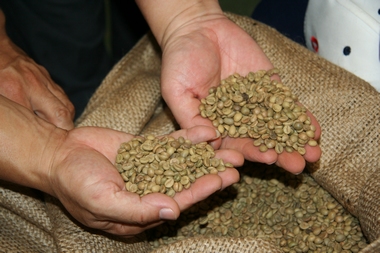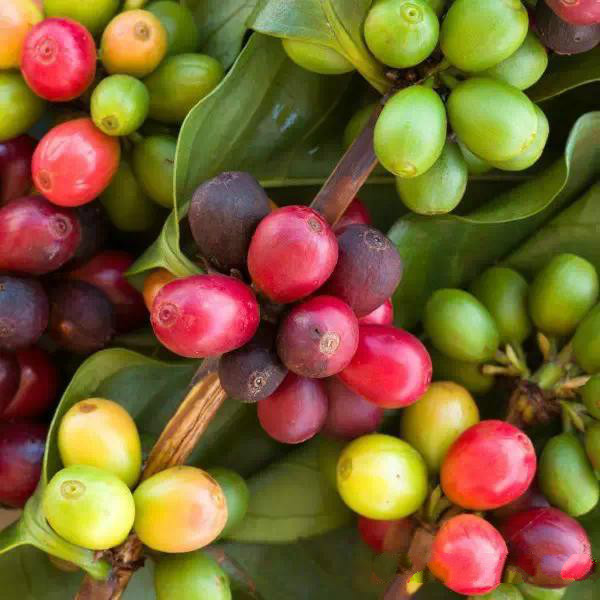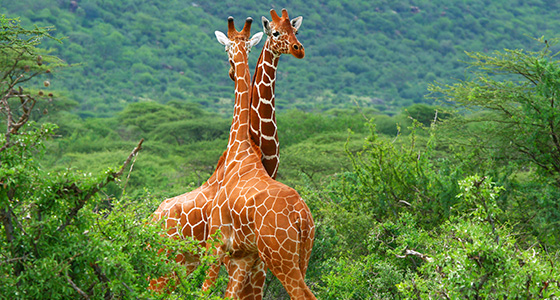The main producing areas of coffee are in southern Brazil and Ethiopian highlands. Ethiopian coffee imports pass.
Ethiopia is one of the major producers of arabica coffee in Africa and produces the best arabica coffee in the world. It is said that coffee was first discovered by shepherds in Ethiopia, and the name of coffee evolved from Kafa, so Ethiopia is still the hometown of coffee.
Coffee production and processing
Ethiopia's geographical environment is very suitable for coffee growth. Coffee is mainly grown in the southern highlands between 1100 and 2300 meters above sea level. The main coffee producing areas are Harar, Limu, Djimma, Sidamo, Kaffa, Yergacheffe and Wellega. The soil in these areas is well drained, slightly acidic, and red and loose.
Ethiopian coffee is harvested once a year. 3-4 Beautiful white coffee blossoms bloom during the month, and then the fruit begins to grow. 9-12 The moon-red coffee fruit ripens and waits to be picked. 11-12 A new season of coffee begins to be exported.
Currently, about 25 percent of Ethiopia's population depends directly or indirectly on coffee production for their livelihood. Farmers using traditional farming methods predominate. Artificial care of coffee trees, use organic fertilizer, do not use harmful pesticides and herbicides, etc. Most of the coffee produced in Ethiopia is organic.
Coffee can be divided into three types: forest-semi-forest coffee, garden coffee and plantation coffee.
60% of coffee is forest-semiforest coffee. In such wild coffee forests, pesticides are not used at all, but biological methods are used to control pests.
35% of coffee is courtyard coffee. In this coffee garden, the planting is three-dimensional distribution. Coffee sits in the lower layers, in the shade of other crops, to get the right environment to grow. Fertilizer is mainly deciduous, withered grass and animal manure.
5% of coffee is plantation coffee. This is a modern way of growing coffee. Coffee is grown as a forest, but new varieties are used and spaced apart from other shade trees.
Due to different processing methods, coffee can be divided into washed coffee and sun-dried coffee.
Washed coffee accounts for 35 per cent of exports. Good quality washed coffee is processed from freshly picked fully ripe fruit, carefully picked and closely monitored by professionals. After picking clean coffee beans on the day of picking to pulp, then fermentation, washing, drying, peeling. The humidity of the processed coffee beans is kept at about 12%.
Sun-cured coffee accounts for 65 per cent of exports. Picked primarily at home, red beans are dried on concrete floors or high tables to a humidity of about 11.5%, then peeled and washed.
Coffee classification and quality control system
In Ethiopia, coffee classification and quality control systems are divided into producer, regional and national levels. All coffees are inspected by local inspection agencies before they leave the country of origin, and then re-inspected at coffee inspection and grading centres in Addis and Diredova to determine their quality grade. Grading coffee before auction and sale is important for all groups involved in production, acquisition, export and consumption. Before export, coffee must also be sent to a national quality control agency for inspection to confirm that origin, color, etc. meet export standards to ensure the reputation of Ethiopian coffee.
At present, Ethiopia's coffee grading and quality control system mainly has two indicators: visual inspection and cup evaluation. The inspection items include color, cleanliness, origin, taste and characteristics of coffee beans. Export classification is indicated by simple numbers, with the best washed coffee being grade 5 and the best sun-cured coffee being grade 4. After classification, the origin can be exported. Usually exports are paid by letter of credit, which can reduce the risk of collection by exporters and give quality assurance to importers.
By law, all coffee must be sold through auctions held in Addis Ababa and Diredava. During the coffee harvest season, such auctions are even held twice a day.
Coffee outlet
Coffee is Ethiopia's most important export cash crop and the main source of foreign exchange earnings. Ethiopia's coffee exports account for about 3% of the world market share, making it the eighth largest coffee exporter in the world. Coffee exports increased steadily from 58,000 tons in 1990-1991 to 110,000 tons in 1995 - 1996 and remained at that level for the next few years. Export volume exceeded 110,000 tons in 2001 - 2002 and reached 127,000 tons in 2002 - 2003. The decade-long decline in coffee prices on the international market has seriously affected Ethiopia's foreign exchange earnings. Coffee exports accounted for more than half of Ethiopia's foreign exchange earnings before coffee prices dropped sharply, but now they account for only about 35 percent. However, coffee prices began to recover in 2002, rising from 41 cents per pound in September 2001 to 52 cents per pound in 2002 and 59.7 cents per pound in 2003, according to the International Coffee Organization. The average price in March 2004 was 60.8 cents per pound, a 50 per cent increase from September 2001. This is great news for Ethiopia.
Ethiopian people are addicted to coffee. In 2003, domestic consumption accounted for 42.3% of the total output, with an average consumption of 3 kg per capita. But more than half of coffee production is exported each year to earn foreign exchange. Major exporting countries include: the United States, Italy, Britain, Sweden, Norway, Greece, France, Belgium, Germany and Australia.
Until 1974, coffee production, processing and trading were in private hands. Private farms were nationalized and smallholder coffee producers neglected during the military regime. In 1991, the Transitional Government of Ethiopia enacted a new economic policy to encourage private coffee exports. As a result, the number of private coffee exporters has increased dramatically. Nearly 90% of coffee exports are now controlled by private exporters.
Characteristics of Ethiopian Coffee
The natural characteristics of coffee beans include size, shape, acidity, texture, taste and aroma. Ethiopia's coffee beans are small, fragrant, and have the same acidity as wine, which is loved by coffee lovers. Due to its unique aroma and taste, Ethiopian coffee is often used in the production and variety improvement of beverages, ice cream and confectionery.
World-famous Ethiopian coffee mainly includes:
1. Limu coffee grows between 1400 meters and 2000 meters above sea level. washed coffee. Excellent quality, with intense nutty aromas, moderate acidity and wine intensity. Annual production of 29,000 tons.
Gima coffee grows between 1400 and 1800 meters above sea level. Sunburn coffee. Slightly sour, nutty and long finish. Annual production of 70,000 tons.
Gambi coffee grows between 1500 and 2300 meters above sea level. A gourmet coffee with moderate acidity and fruity aromas. Annual production of 34,000 tons.
4. Yeerga Chefa coffee grows at an altitude of 1500 meters to 2200 meters. Mocha flavor with floral and spicy aromas. Annual production is approximately 28,000 tons.
5. Sidamo coffee grows at an altitude of 1400 - 2200 meters. Good acidity, good quality. Annual production is approximately 37,000 tons.
Harald coffee grows at altitudes above 2700 meters. It's the best coffee in the world, medium acidity, intoxicating exotic flavor, with a slightly intoxicated, dry fruit aroma, pure mocha coffee. Annual production is approximately 26,000 tons.
wholesale price
Yerga Shefi G3 Banki Magee Medium Roast Sunlight 78.00 156.00 Jackfruit, Spices, Wine
Yegashefi G1 Giddo Medium Baked Sunlight 85.00 170.00 Blueberries, Honey, Purple Fruit, Citrus Tone
Yerga Shefi G1 Erica Light Baked Sunlight 95.00 190.00 Light Fermented Bouquet, Sweet Orange, Spice, Sweet Honey
Yega Shefi G2 Dama Cooperative Light Baked Wash 75.00 150.00 Lemon Peel, Black Tea, Dried Longan, Floral
Yerga Shefi G2 Cochere Light Baked Wash 69.00 138.00 Jasmine, lemon, bergamot, honey, black tea
Sitama G2 Sitama Region Light Baked Wash 69.00 138.00 Wild Ginger Flowers, Honey, Citrus, Lemons
Sidama G1 Guji Light Baked Sunlight 79.00 158.00 Jasmine, Honey, Citrus, Ripe Berry

Important Notice :
前街咖啡 FrontStreet Coffee has moved to new addredd:
FrontStreet Coffee Address: 315,Donghua East Road,GuangZhou
Tel:020 38364473
- Prev

Arabica coffee beans wholesale price of Ethiopian coffee beans ILLY Italian Starbucks site
Ethiopia is one of the major producers of Arabica coffee in Africa, producing the best Arabian coffee in the world. It is said that coffee was first discovered by shepherds in Essekafa, and the name of coffee evolved from Kafa, so Essex is still the hometown of coffee. The geographical environment of coffee production and processing is very suitable for coffee growth. Coffee is mainly cultivated.
- Next

Kenyan coffee grades: what brand of Kenyan coffee is Kenya AA?
Kenyan coffee is mostly grown at an altitude of 1500m, 2100m, and is harvested twice a year. Its main feature is a distinct fruit aroma, the common fruit aroma is citrus. Kenyan coffee has a multi-layered taste and juice acidity, perfect grapefruit and wine flavor, moderate mellow, is the favorite of many people in the coffee industry. Kenya Coffee borrows Hollywood movies
Related
- Does Rose Summer choose Blue, Green or Red? Detailed explanation of Rose Summer Coffee plots and Classification in Panamanian Jade Manor
- What is the difference between the origin, producing area, processing plant, cooperative and manor of coffee beans?
- How fine does the espresso powder fit? how to grind the espresso?
- Sca coffee roasting degree color card coffee roasting degree 8 roasting color values what do you mean?
- The practice of lattes: how to make lattes at home
- Introduction to Indonesian Fine Coffee beans-- Java Coffee producing area of Indonesian Arabica Coffee
- How much will the flavor of light and medium roasted rose summer be expressed? What baking level is rose summer suitable for?
- Introduction to the characteristics of washing, sun-drying or wet-planing coffee commonly used in Mantenin, Indonesia
- Price characteristics of Arabica Coffee Bean Starbucks introduction to Manning Coffee Bean Taste producing area Variety Manor
- What is the authentic Yega flavor? What are the flavor characteristics of the really excellent Yejasuffi coffee beans?

